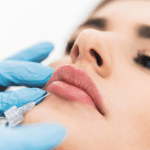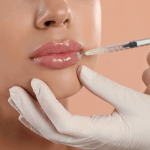Age-related macular degeneration (AMD) is the primary cause of vision loss among older adults. It affects the macula, the central part of the retina responsible for clear, straight-ahead vision required for reading, driving, and recognizing faces.
Age-related macular degeneration poses a significant challenge to maintaining vision health in the aging population. Medical practitioners can effectively manage age-related macular degeneration by using tools like the macular degeneration chart and OCT, conducting comprehensive tests, staying updated on the latest medications, and understanding the differences between wet and dry types of the disease.
Evaluating Vision Changes in Age-related Macular Degeneration Patients
A macular degeneration chart is an essential tool in diagnosing and monitoring age-related macular degeneration. These charts, such as the Amsler grid, help independently detect visual distortions that patients may overlook. The chart consists of a horizontal and vertical grid with a center fixation point. Patients with age-related macular degeneration may see wavy lines or blurred spots when looking at the grid, indicating macular changes. Regular use of these charts can help track disease progression and the effectiveness of treatments.
Understanding Macular Degeneration Test
Testing for macular degeneration involves several methods to assess the macula’s health and detect early signs of age-related macular degeneration. Comprehensive eye exams, including visual acuity tests, dilated eye exams, and fundus photography, are critical. Optical coherence tomography (OCT) is a non-invasive imaging examination that produces comprehensive cross-sectional images of the retina, allowing for early detection of structural changes in the macula. Fluorescein angiography may also be used to examine and determine blood flow in the retina and locate any abnormalities.
Pharmacological Treatments for Macular Degeneration
Medication plays a vital role in managing age-related macular degeneration, particularly the wet form of the disease. Anti-VEGF (vascular endothelial growth factor) drugs, such as ranibizumab, aflibercept, and bevacizumab, are commonly used to prevent aberrant blood vessel development and minimize fluid leaks in the retina. These macular degeneration medications are administered through intravitreal injections and have been shown to stabilize and even improve vision in many patients. Practitioners must stay updated on the latest pharmacological advancements and treatment protocols.
Macular Degeneration Optical Coherence Tomography
Optical coherence tomography (OCT) has revolutionized diagnosing and managing macular degeneration. This imaging technique provides high-resolution, cross-sectional retina images, allowing for detailed visualization of the macula’s layers. OCT is instrumental in detecting early signs of age-related macular degeneration, such as drusen deposits and retinal pigment epithelium changes, before they significantly impact vision. Regular OCT scans are essential for monitoring disease progression and evaluating the effectiveness of treatments.
Distinguishing Between Wet and Dry Macular Degeneration
Understanding the difference between wet and dry macular degeneration is crucial for appropriate management. Dry age-related macular degeneration, the more common form, is characterized by the accumulation of drusen and gradual thinning of the macula. It progresses slowly and often leads to central vision loss over time. Conversely, wet age-related macular degeneration involves abnormal blood vessel growth beneath the retina, leading to leakage and scarring. This form progresses rapidly and can cause significant vision loss if not treated promptly. Early detection and differentiation between these types are vital for effective treatment strategies.
Frequently Asked Questions (FAQs)
Is macular degeneration hereditary?
Yes, macular degeneration can be hereditary. Research has shown that people with a family history of age-related macular degeneration (AMD) have a higher risk of developing the condition themselves. Specific genetic variants, such as those in the complement factor H (CFH) gene and the ARMS2/HTRA1 region, have been linked to an increased susceptibility to age-related macular degeneration.
How to prevent macular degeneration?
Medical practitioners should advise patients on a combination of lifestyle modifications and regular monitoring to prevent macular degeneration. Emphasize the importance of a diet rich in antioxidants, vitamins C and E, zinc, and omega-3 fatty acids, which can be found in leafy greens, fish, and nuts. Encourage smoking cessation, as smoking significantly increases the risk of age-related macular degeneration. Regular exercise and maintaining a healthy weight also help overall eye health. Additionally, patients should protect their eyes from excessive UV exposure by wearing sunglasses with UV protection.
What are the latest advancements in the treatment of macular degeneration?
Recent advances in treating macular degeneration include the development of new anti-VEGF (vascular endothelial growth factor) therapies, which are more effective and require fewer injections than earlier treatments. Gene therapy is also being explored as a potential treatment, aiming to correct genetic defects or provide the retina with the tools to combat age-related macular degeneration. Additionally, research into stem cell therapy holds promise for regenerating damaged retinal cells. Advances in imaging technologies, such as enhanced depth imaging OCT, allow for better monitoring and early detection of age-related macular degeneration, leading to more timely and targeted interventions.
Can lifestyle changes impact the progression of macular degeneration?
Yes, lifestyle changes can significantly impact the progression of macular degeneration. Adopting a healthy diet rich in antioxidants, vitamins, and minerals can help slow the disease’s progression. Regular physical activity, maintaining a healthy weight, and avoiding smoking are also crucial. These changes can reduce oxidative stress and inflammation, critical factors in the development and progression of age-related macular degeneration.
What is GA eye disease?
Geographic atrophy (GA) is an advanced kind of age-related macular degeneration (AMD). It is the major cause of visual loss in older adults. The progressive degeneration of the macula characterizes GA, the center region of the retina responsible for sharp, detailed vision. This syndrome causes the gradual loss of central vision, making reading, driving, and recognizing faces increasingly tricky. Unlike the “wet” form of AMD, GA is a “dry” form, meaning it does not involve abnormal blood vessel growth but rather the atrophy or thinning of the macular tissue. While treatments to slow the progression of GA are emerging, there is currently no cure, highlighting the significance of frequent eye exams and early detection in managing the disease.





